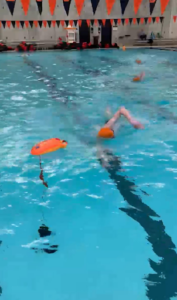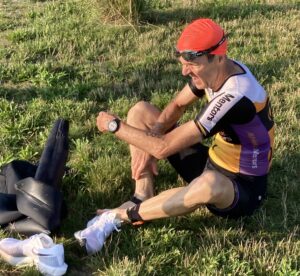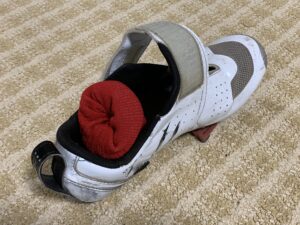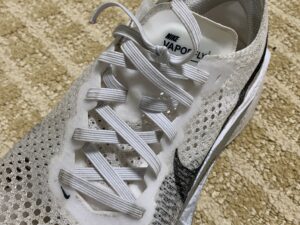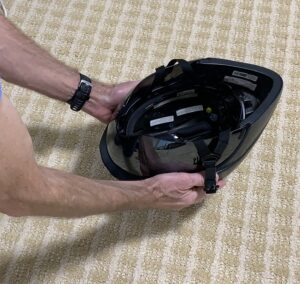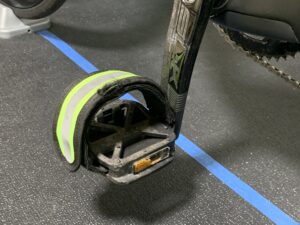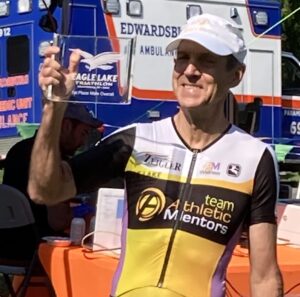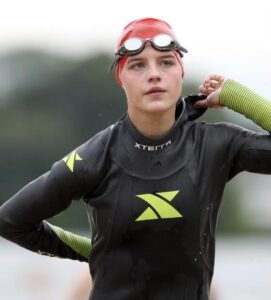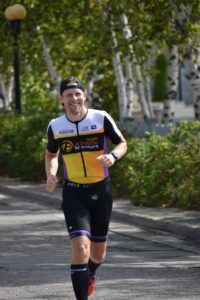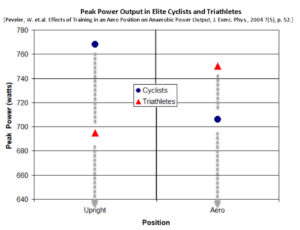By: Natalie Rowe
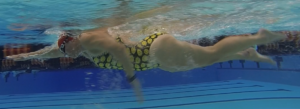 A few weeks ago, Athletic Mentors hosted their Swim Stroke Video Analysis. There were 12 of us that participated, many of us fairly experienced swimmers…but after watching the videos, we all had technique issues, mostly hand entry and catch issues. Just to give you an idea, I grabbed an image from one of my videos to show you what we saw under the water.
A few weeks ago, Athletic Mentors hosted their Swim Stroke Video Analysis. There were 12 of us that participated, many of us fairly experienced swimmers…but after watching the videos, we all had technique issues, mostly hand entry and catch issues. Just to give you an idea, I grabbed an image from one of my videos to show you what we saw under the water.
When we met and reviewed our videos as a group, we started talking about the upcoming racing season, training and triathlon in general. It got me thinking…we were all beginners at some point and pretty clueless about all things triathlon. I thought it would be fun if a few experienced triathletes answered some of the top Googled questions about triathlon. I went to Google, looked over the questions and selected 5 questions that I thought would be helpful, and truthfully I’ve also been asked during training!
For those totally new to triathlon or multi-sport, I want to give you a foundation to start with. Typically, it’s three sports; swim, bike, and run performed consecutively in that order. There are other events in the family too; like duathlon, aquathon and aquabike (and other variations which we won’t get into). Now that we’ve clarified what a triathlon is, there are different triathlon distances, but the shortest standardized distance is a sprint triathlon and the longest is the iron distance. There are shorter and longer distances, but they’re not standardized. Here is a chart of what the distances look like:
| Name of Event |
Swim Distance |
Bike Distance |
Run Distance |
| Sprint |
750m* |
20K / 12.4 miles |
5K / 3.1 miles |
| Olympic |
1500m* |
40K / 24.8 miles |
10K / 6.2 miles |
| Half Iron / 70.3 |
1.2 miles |
56 miles |
13.1 miles |
| Iron / 140.6 |
2.4 miles |
112 miles |
26.2 miles |

Jay
Jay – What makes it “standardized’? If USAT (USA Triathlon) hosts a National Championship at that distance, does that make it “standard”? For example, USAT hosts a National Championship at the Super Sprint distance each year at the Multisport Festival. There is also a Super Sprint World Championship race.
Natalie – after Jay asked this question, I went back and did more research! Low and behold, there are different standards for different organizations. Since we’re US based, it seems appropriate to use what USAT deems standard. As it turns out USAT does include Super Sprint in their standard distances, they also include the World Triathlon Long Course. Here’s the fully updated chart:
| Name of Event |
Swim Distance |
Bike Distance |
Run Distance |
Total Distance |
| Super Sprint |
400m |
10K / 6.2 miles |
2.5K |
12.9K |
| Sprint |
750m |
20K/ 12.4 miles |
5K / 3.1 miles |
25.75K |
| Olympic |
1500m |
40K / 24.8 miles |
10K / 6.2 miles |
51.5K |
| World Triathlon Long Course |
2,000m |
80K / 49.6 miles |
20K / 12.4 miles |
102K |
| Half Iron / 70.3 |
1.2 miles |
56 miles |
13.1 miles |
70.3 miles |
| Full Iron / 140.6 |
2.4 miles |
112 miles |
26.6 miles |
140.6 miles |
Before we get to the questions, I asked everyone to share how long they’ve been participating in triathlon and if there is anything else about each of us that will give you insight into who we are or our background.
Natalie: I’m the rookie of the group. I played water polo in high school and college. After many years of not being active, I started running mostly to lose weight and get in shape – it worked, but I became incredibly bored with just running, so I started migrating over to multisport and have been at it for about 5 years.

Dawn
Dawn: Swimmer for the fun of it before I could walk. Always a learner, I study triathlon and techniques to be the best athlete I can be. That education and desire to share it with others led me to become a USAT Certified Triathlon Coach.
Jay: My first triathlon was as a team member (running leg) in the 1993 Gull Lake Triathlon. I started running in college… mostly to deal with stress. My first race ever was a marathon in 1978. I drifted to triathlon because I needed a new challenge.
Kathy: As strictly a runner, I discovered Triathlon after suffering some sport related injury due to the constant pounding of running. I loved the variety the training provided and the adventure of the races. I decided to “Tri” my first triathlon in 2007 and started sharing my passion for the sport as a USAT Certified Triathlon Coach in 2020.
1) Do you do all 3 disciplines every day?
Natalie: No one has time for that! When I train; most of my training days I’m doing 2 workouts, occasionally back to back but the only time I’m doing all 3 disciplines is if I’m doing a mock race or actually racing.
Dawn: No. Most individuals do not have time for that and then you wouldn’t be able to focus and improve on your weakness. I do have my athletes practice bricks, two workouts done consecutively with the purpose of improving race pacing. The most typical brick is a bike followed by a run. I also have them practice very short triathlons during race season to practice their transitions, that is, changing from one sport to the next.
Jay: I generally shoot for 10 workouts per week. My magic formula was always 4-3-2-1 ..meaning 4 bikes, 3 runs, 2 swims, 1 strength. I won’t disclose my current formula 😉
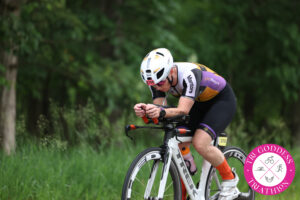
Kathy
Kathy: I tackle the disciplines in 2’s (as a minimum): 2 bikes, 2 runs, 2 swims, 2 strengths. While this does mean doing more than 1 workout in a day, it is usually broken up into 1 before work and 1 during lunch or after work. With working full-time and having a family, that schedule may not always be achievable. If I have to pick and choose workouts during the off season, I focus on strength training and the weakest of my 3 disciplines.
2) So, you swim, bike and run all in the same day…do you get any breaks?
Natalie: There is a transition between each discipline, depending on the distance it could be as quick as putting on shoes (or switching shoes) or as long as doing an almost complete wardrobe change – which for an Iron distance, I did actually change everything I was wearing except for my sports bra. Even with a full wardrobe change, that was only about 7 minutes.
Dawn: I wouldn’t call transition a break. As you are just starting out in triathlon use the transition time to prepare yourself mentally and physically for the next sport. Speed will come in time.
Jay: Triathlon is an endurance sport. There is no sense in sprinting or in taking-a-break. Pace pace pace.
Kathy: There are no “breaks” during a triathlon and only a “transition” from one discipline to the next. This transition is included in your total race time, so it is often called the 4th discipline in triathlon. As you become more experienced in triathlon and want to look at improving your race times, improving your transition is the easiest way to save valuable minutes. We also refer to it as “free speed”. Practice, practice, practice.
3) Do you run in bike shorts (the ones with all of the padding)?

Natalie
Natalie: I have done it, but for me personally, I don’t recommend it. On race day, I typically wear a tri short that has a chamois, but is much smaller than a traditional bike short. It does take time to get comfortable with something smaller. The one additional thing I would say about apparel, I didn’t really know what to buy when I first started, I bought inexpensive shorts and gear, but I quickly learned that you get what you pay for. The more expensive gear is typically a higher quality and has been significantly more comfortable.
Dawn: I’m one of the few people who doesn’t mind cycling shorts while running. Mostly because the run off the bike in a training session will be rather short. I wear a Triathlon Kit with thinner padding for races.
Jay: I come from the generation that wore Speedos on the bike. Wear what you feel comfortable in. You will find that as you spend more time in the aero position on the bike, that you need less padding. To answer your question…never.
Kathy: I would compare running in bike shorts to running in a soggy diaper. For a brick workout (bike followed by a run), if I wear cycling shorts on the bike, I will change into run shorts as I transition to the run. During race day, changing isn’t an option, so I use triathlon shorts that have a much smaller chamois that dries quickly.
4) How do you go to the bathroom?
Natalie: Personally, if I have to go – I’m going to stop and use a port-o-john. I’m never going to be so fast that I can’t stop to go to the bathroom. And if I have to go that bad, if I tried to push to finish, I would be miserable…not worth it!
Dawn: I agree with Natalie here.
Jay: I’m not much help. My longest distances are marathons and half-ironman. In the hundreds of race I have done, I have never used the bathroom during the actual race….its a gift. I must admit that lined up in my wetsuit prior to the start, I have watered the grass.
Kathy: I have learned over the years to use the bathroom whenever and wherever possible. That may be the port-a-john, the lake, or even (full disclosure) sitting on the ground in transition.
5) What advice would you give someone who is curious about trying a triathlon? (Ha, see what I did there.)
Natalie: Hire a coach. When I first started, I just followed a generic plan, which got me from start to finish, however I didn’t have anyone to lean on for questions or anything for that matter. For the Unique 10 stage adventure triathlon (in Michigan) I used a remote coach but realized pretty quickly how much I preferred having a local coach to help guide me. There are options for all budget levels, but this was a game changer for me.
Dawn: Practice. Whether you read a book about triathlon, have a friend who can share their knowledge with you or hire a Coach, seek out knowledge to plan how you will get ready for your first triathlon. Before your race, lay out everything you will need for the race from start to finish. Then mentally and physically go through the steps, this includes getting wet and practicing how you will remove your cap, goggles etc before putting on your helmet and shoes to get on your bike. Remember, your first race should be enjoyable. If you are worried about being fast that will come later.
Jay: Don’t overthink it. A lot of technology has made triathlon more complex than when we just put on our swimsuits and dragged out the Schwinn. But there is nothing wrong with old-style. Don’t get intimidated by the gear of others.
Kathy: Volunteer at a triathlon. Volunteering gives you an inside view of the in’s and out’s of a triathlon. It will help you to gain valuable experience while also helping to support the event.
This ended up being a really fun way for me to learn about the sport, find some really unique multi-sport events and how other athletes think about triathlon. Here are a couple of things I thought could be helpful, plus an event that might be added to my bucket list!
Learn more about USA Triathlon and all things Multisport
Grand Rapids Triathlon is one of my favorite independent races in Michigan. They offer Super Sprint, Sprint, Olympic and Half Distance at their 2-day event. It’s a great beginner event!
Unique 10 stage adventure triathlon (in Michigan) is the Battle of Waterloo











